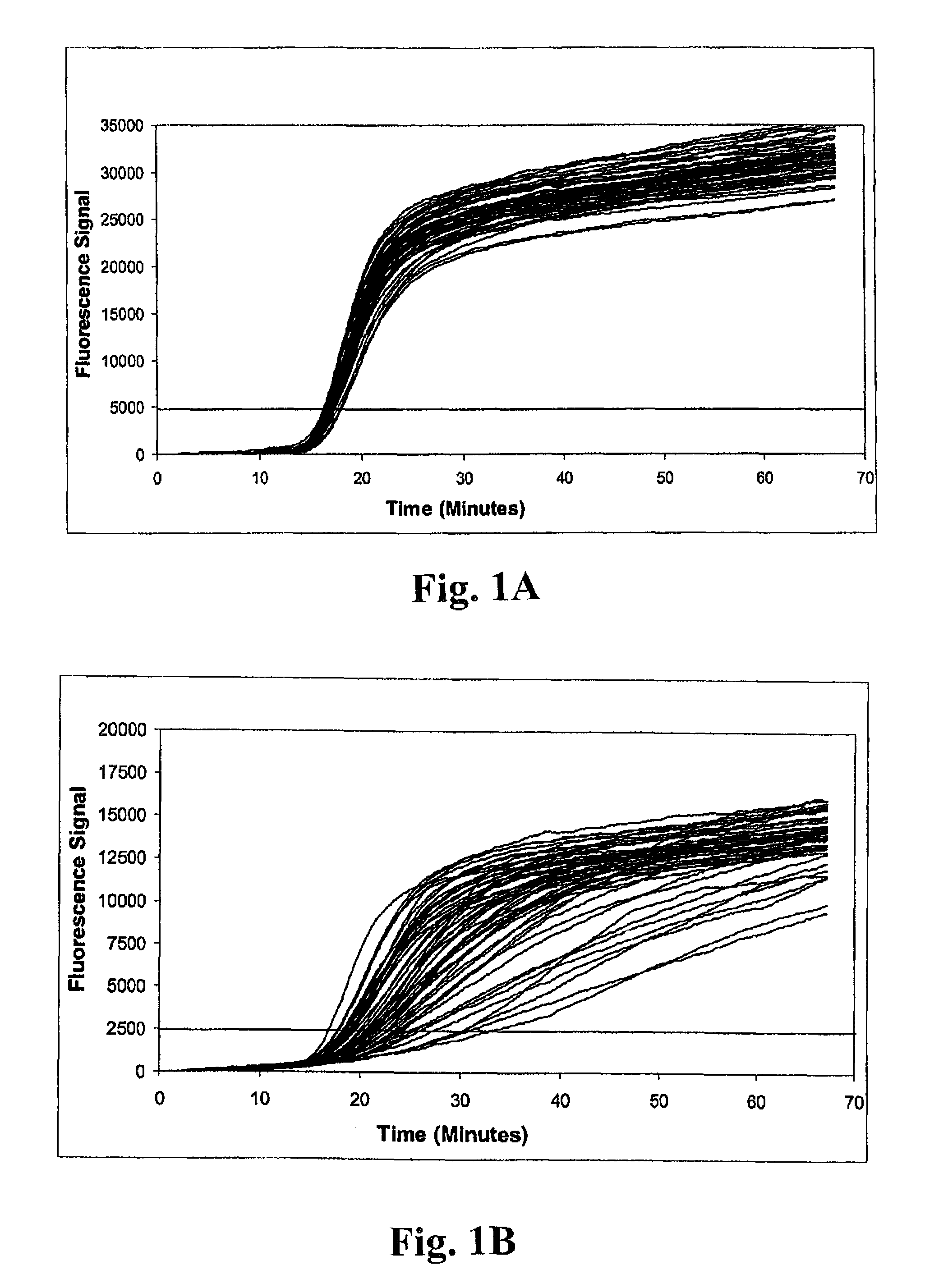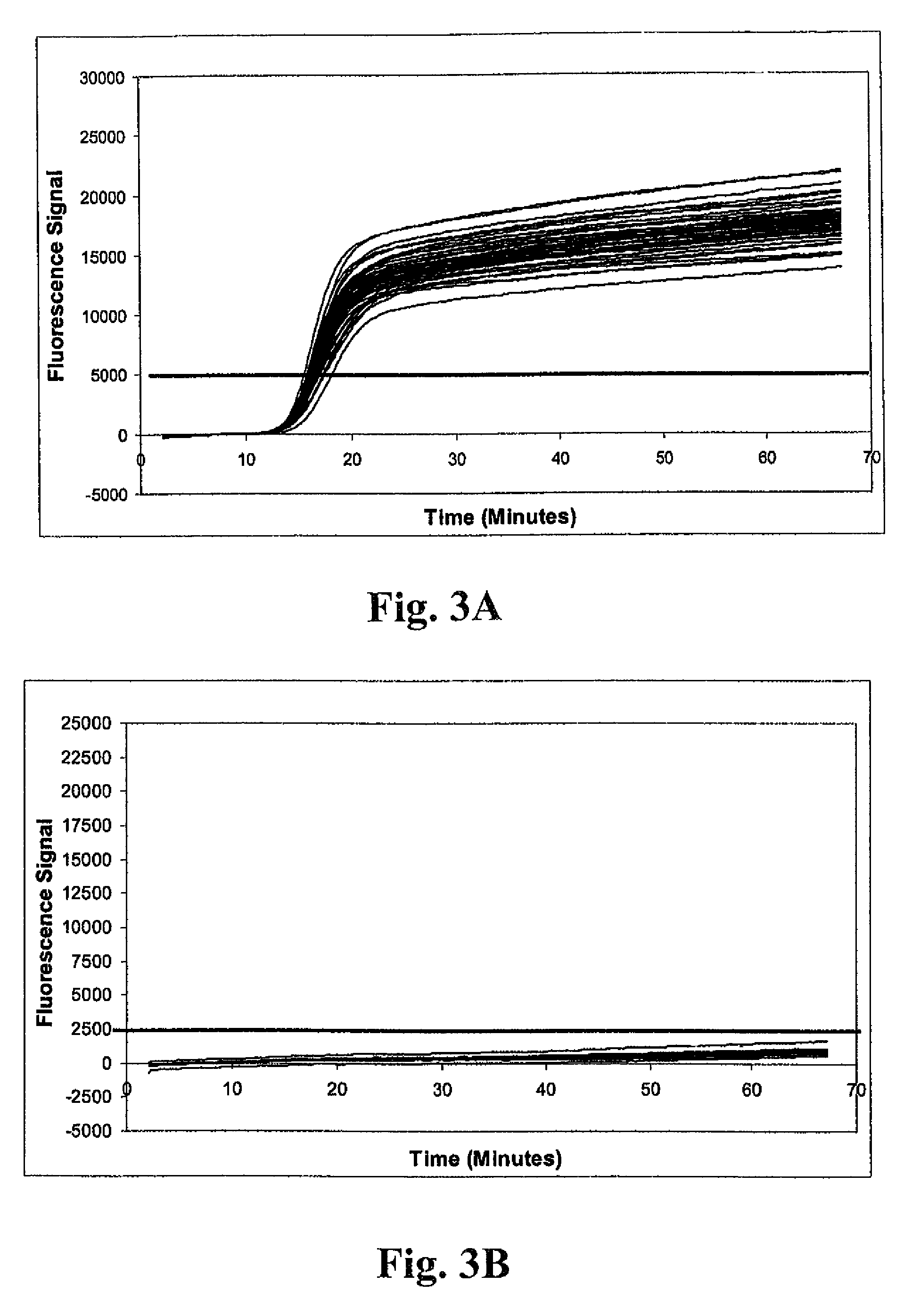Detection of antibiotic-resistant microorganisms
a technology of antibiotic-resistant microorganisms and detection methods, applied in the field of biotechnology, can solve the problems of increasing the magnitude of the mrsa problem, failing to establish physical linkage between the two sequences, and increasing human and economic tolls, so as to facilitate the separation of bound target nucleic acids
- Summary
- Abstract
- Description
- Claims
- Application Information
AI Technical Summary
Benefits of technology
Problems solved by technology
Method used
Image
Examples
working examples
[0145]The general principles of the present invention may be more fully appreciated by reference to the following non-limiting Examples.
[0146]Example 1 illustrates the detection of MRSA and MSSA bacteria using a multiplex real-time amplification assay. Three independent single-primer transcription-associated amplification assays were used for amplifying and detecting S. aureus 23S rDNA, mecA DNA and an unrelated artificial internal control DNA in a single tube. Each of the three nucleic acid targets in the procedure was amplified using unique amplification oligonucleotides, and was detected using unique molecular torches. As described below, procedures were performed to assess detection of small quantities of MRSA bacteria in samples containing large excesses of either (a) the combination of two different methicillin-sensitive coagulase-negative staphylococcus bacteria (i.e., S. haemolyticus and S. epidermidis), or (b) MSSA. As well, detection of small quantities of MSSA bacteria in...
example 1
Detection of MRSA and MSSA in the Presence of Closely Related Organisms
[0147]Samples containing bacterial targets used for testing were prepared as follows. Sterile BBL CULTURE SWABS (Becton, Dickinson and Company) were inserted into companion tubes containing Stuart's Medium and allowed to stand for at least 6 hours at room temperature to simulate batch collection conditions. Individual swabs were transferred into 1.7 ml Eppendorf reaction tubes containing 250 μl of a sample buffer solution consisting of 10 mM Tris (pH 8.0) and 1 mM EDTA. Excess lengths of swab applicator handles were removed to permit containment of the swabs in the reaction tubes. Tubes were subsequently capped shut and vortexed for 30 seconds. Swabs were removed immediately after vortexing. Next, 80 μl of residual sample buffer was transferred into each of two 1.7 ml Eppendorf reaction tubes. Replicate tubes next received 20 μl aliquots containing known quantities of bacteria for one of three different challenge...
example 2
Real-Time Analysis of MRSA-Negative Clinical Samples
[0157]Fifty-five nasal swab samples negative for MRSA were tested in a multiplex real-time amplification system, and determinations of the presence or absence of the S. aureus and mecA target nucleic acids made essentially as described under Example 1. Real-time run curves were analyzed to determine indicia of amplification based on attainment of a threshold fluorescence value using MXPRO QPCR real-time analytical software (Stratagene; La Jolla, Calif.). Where Ct values were determined, the values were averaged and used for calculation of ΔCt values.
[0158]Representative run curves from the real-time amplification procedure are shown in FIGS. 5A-5E. All panels graphically depict results for amplification of internal control, S. aureus 23S rDNA, and mecA target sequences. Individual amplification reactions were scored as positive using acceptance criteria essentially as described under Example 1. FIG. 5A shows results for a negative ...
PUM
| Property | Measurement | Unit |
|---|---|---|
| time | aaaaa | aaaaa |
| temperature | aaaaa | aaaaa |
| melting temperature | aaaaa | aaaaa |
Abstract
Description
Claims
Application Information
 Login to View More
Login to View More - R&D
- Intellectual Property
- Life Sciences
- Materials
- Tech Scout
- Unparalleled Data Quality
- Higher Quality Content
- 60% Fewer Hallucinations
Browse by: Latest US Patents, China's latest patents, Technical Efficacy Thesaurus, Application Domain, Technology Topic, Popular Technical Reports.
© 2025 PatSnap. All rights reserved.Legal|Privacy policy|Modern Slavery Act Transparency Statement|Sitemap|About US| Contact US: help@patsnap.com



